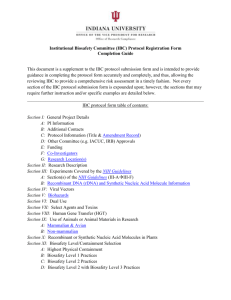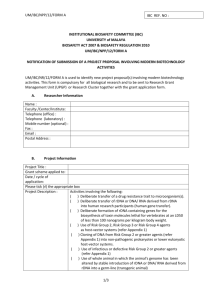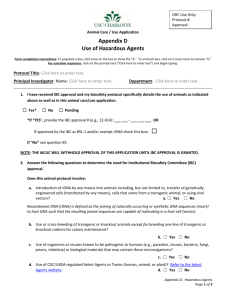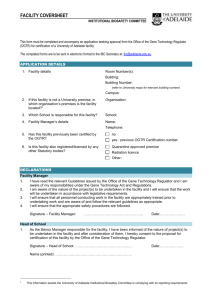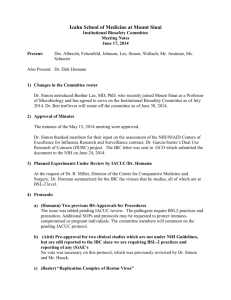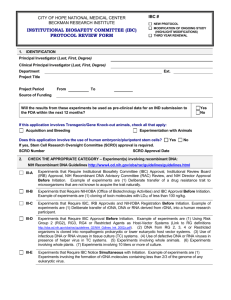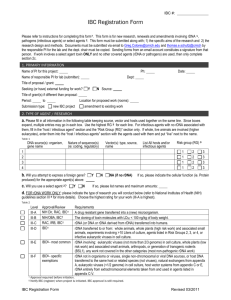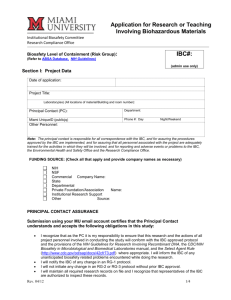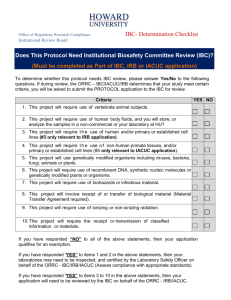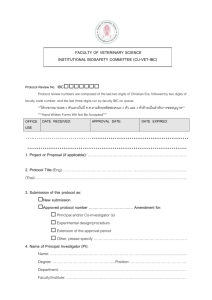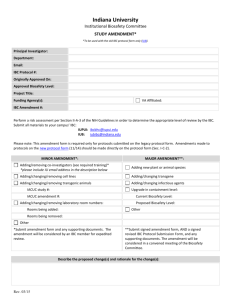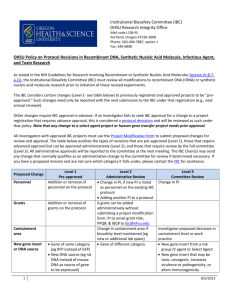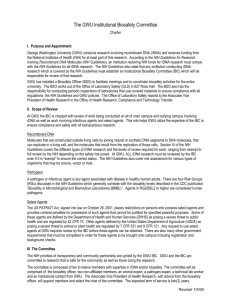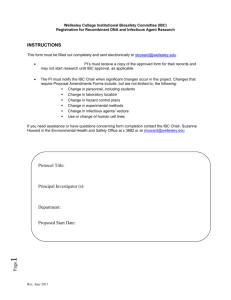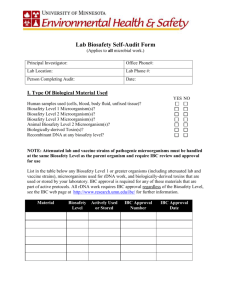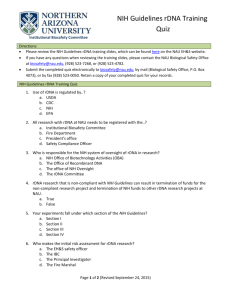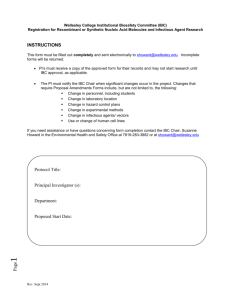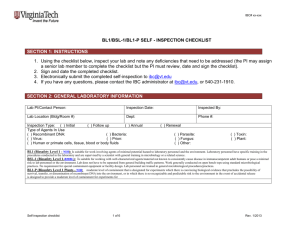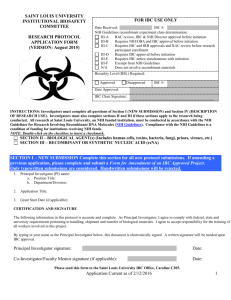registration document for recombinant dna experiments
advertisement
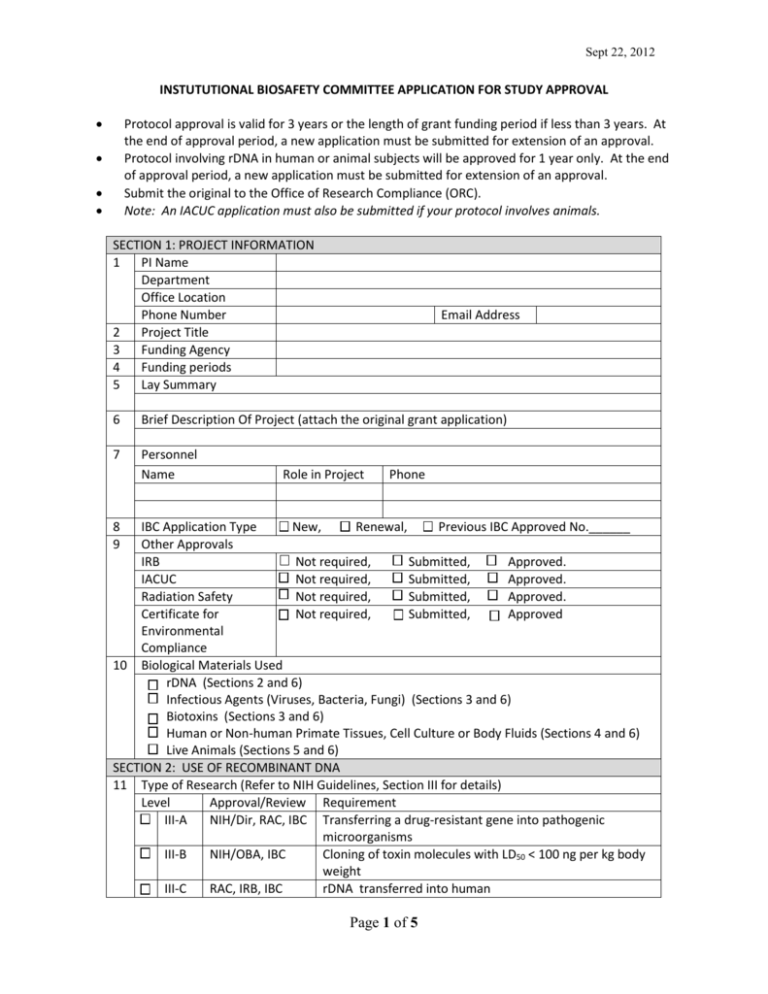
Sept 22, 2012 INSTUTUTIONAL BIOSAFETY COMMITTEE APPLICATION FOR STUDY APPROVAL Protocol approval is valid for 3 years or the length of grant funding period if less than 3 years. At the end of approval period, a new application must be submitted for extension of an approval. Protocol involving rDNA in human or animal subjects will be approved for 1 year only. At the end of approval period, a new application must be submitted for extension of an approval. Submit the original to the Office of Research Compliance (ORC). Note: An IACUC application must also be submitted if your protocol involves animals. SECTION 1: PROJECT INFORMATION 1 PI Name Department Office Location Phone Number 2 Project Title 3 Funding Agency 4 Funding periods 5 Lay Summary Email Address 6 Brief Description Of Project (attach the original grant application) 7 Personnel Name Role in Project Phone 8 9 IBC Application Type New, Renewal, Previous IBC Approved No.______ Other Approvals IRB Not required, Submitted, Approved. IACUC Not required, Submitted, Approved. Radiation Safety Not required, Submitted, Approved. Certificate for Not required, Submitted, Approved Environmental Compliance 10 Biological Materials Used rDNA (Sections 2 and 6) Infectious Agents (Viruses, Bacteria, Fungi) (Sections 3 and 6) Biotoxins (Sections 3 and 6) Human or Non-human Primate Tissues, Cell Culture or Body Fluids (Sections 4 and 6) Live Animals (Sections 5 and 6) SECTION 2: USE OF RECOMBINANT DNA 11 Type of Research (Refer to NIH Guidelines, Section III for details) Level Approval/Review Requirement III-A NIH/Dir, RAC, IBC Transferring a drug-resistant gene into pathogenic microorganisms III-B NIH/OBA, IBC Cloning of toxin molecules with LD50 < 100 ng per kg body weight III-C RAC, IRB, IBC rDNA transferred into human Page 1 of 5 Sept 22, 2012 III-D 12 13 IBC, (IACUC) rDNA transferred to or from: whole animals, whole plant (high risk group), agents listed in Risk Group 2, 3, or 4 or infective eukaryotic viruses in cell culture III-E IBC, (IACUC) rDNA involving: eukaryotic viruses (not more than 2/3 genome) in cell culture, whole plant (low risk group), arthropods, or generation of transgenic rodents (BSL1), any work not covered in other categories (most nonpathogenic rDNA work) Description of DNA Vector (List all plasmids/ vectors, use additional paper if needed) Name Origin Virus, Bacterium, Yeast, Fungus, Animal, Plant, Source Purified /constructed in PI’s lab. Purchased. Vender: _________ Others. Specify_______ If it is a viral vector, is it replicative? Yes. Please complete Section 3. No. If it is a non-replicative viral vector, is Yes. Provide documented evidence for helper virus or cell line packed with complete removal of the replication required replication required genes used in genes. preparation? No Description of Gene Insert (List all gene inserts, use additional paper if needed) Origin Virus, Bacterium, yeast Fungus, Human, Non-human animal, specify______ Plant Source Synthesized/Isolated in PI’s lab. Purchased. Vender: _________ Others. Specify ____________ Attach a map of the final construct including the vector and the insert. Does the insert represent more than 2/3 of the viral genome? Yes, No Is this a deliberate attempt to express a foreign gene in the cloning Yes, No vehicle? Can this gene be expressed in mammalian cells or cell lines? Yes, No Will this expressed gene product be purified? Yes No Description of the biological activity of expressed gene product or the nature of gene sequence if the gene is not intent to be expressed 14 List of all plasmid/genetic construct and host(s), such as E. coli, yeast, cell line, or mouse for each construct. (*The table can be expanded if more than 2 hosts or constructs are used) Host Strain Plasmid/Construct 15 Detail description of the purpose and use of the each plasmid/genetic construct in respective host listed in 14. 16 What are the potential harms to humans for inadvertent exposure (contact, injection, inhalation, or ingestion) to the genetic construct, expressed gene product, or host Page 2 of 5 Sept 22, 2012 harboring this genetic construct and release of these agents to the environment? 17 How will the laboratory personnel be protected from such exposures? SECTION 3: USE OF INFECTIOUS AGENT AND BIOLOGICAL TOXIN 18 Risk Group of Agent or Toxin Used (Refer to NIH Guidelines, Appendix B for details) 1 Agent that is not associated with human disease 2 Agent that is associated with human disease which is rarely serious and for which preventive or therapeutic interventions are often available 3 Agent that is associated with serious or lethal disease for which preventive or therapeutic interventions may be available 4 Agent that is associated with serious or lethal disease for which preventive or therapeutic interventions are not usually available Is it a select agent? Yes , Category ___ No Name of Agent Source of Agent 19 What are the diseases or pathologic effects associated with the agent? 20 Detail Description of the Use of the Agent 21 What are the preventive and protective measures for the inadvertent exposure (contact, injection, inhalation, or ingestion) or release of agents to the environment? SECTION 4: USE OF BLOOD AND OTHER BODY FLUIDS, UNFIXED TISSUES, PRIMARY CELL CULTURE DERIVED FROM HUMAN OR NON-HUMAN PRIMATES 22 Type of Bio-specimen Source 23 Will this specimen be tested for the possible presence of infectious agents? Yes, Hepatitis HIV Others, specify______, No, Please provide liability statements and/or evidence for the absence of infectious agent. 24 Detail Description of the Use of the Bio-specimen 25 How will the laboratory personnel be protected from the exposures of the possible presence of infectious agents in the bio-specimen if the evidence for the absence of infectious agent is not provided in Item 23? SECTION 5: USE OF LIVE ANIMALS 26 Animal Information Species______________ Gender____________ Quantity_____________ Location of Housing Biosafety Level 27 Detail description of the procedures that will be conducted on the animals in the Animal Housing Facility. What are the health risks to the animal caretaker? Page 3 of 5 Sept 22, 2012 What are preventive measures for such risks? 28 Will animals be removed from the housing area for study? Yes. Provide Permission from the Director of Veterinary Service. No. How animals will be transported? What procedures will be conducted on the animals outside the animal housing facility? How will the laboratory personnel be protected from the health risks that may incur? 29 Method of Decontamination of Equipment Used for the Animal Studies Equipment Method of Decontamination SECTION 6: LABORATORY INFORMATION 30 Sites for Conducting Study Location Biosafety Level (submit the laboratory safety level checklist) Phone Date of Inspection (for BSL2 or higher) Biohazard Signs Yes Posted Method of Biohazardous Waste Disposal No Decontamination Procedure for Working Area 31 Biosafety Cabinets Manufacturer Class/Type Location Certification Date Decontamination Procedure 32 33 Personal Protective Equipment Gloves Type Eye Protection Type Foot Protection Type Protective Clothing Type Respiratory Protection Type Others List Emergency Plan What are the courses of actions to manage the accident if inadvertent exposure (contact, injection, ingestion, or inhalation) and release of agents to the environment occur? Contact Person(s) Contact Phone Number Page 4 of 5 Sept 22, 2012 34 Personnel’s Safety Training Name Safety Training Date Certificate No. (PI) ASSURANCE OF PI By attaching my name, I agree to the following 1) I have read and agree to comply with the requirement specified by the NIH Guideline involving Recombinant DNA. 2) I have read and am familiar with the standard and special microbiological practices, containment equipment, personal protective equipment, and laboratory facilities recommended for the Biosafety level indicated by CDC/NIH applicable to this project. 3) I accept the responsibility for training and safety of all laboratory workers involved in the project. All research personnel are familiar with and understand the relevant biosafety practice, protective equipment and techniques, potential biohazards, and emergency procedures. 4) I verify that all items described above are accurate. PI Printed name Signature Date Printed name Signature Date Division Chair For IBC Use Only IBC File no. Date Received IBC Recommendation Approved, from ______to ______ Approved with Provisions Disapproved Date Date of IBC Notification to PI Page 5 of 5

